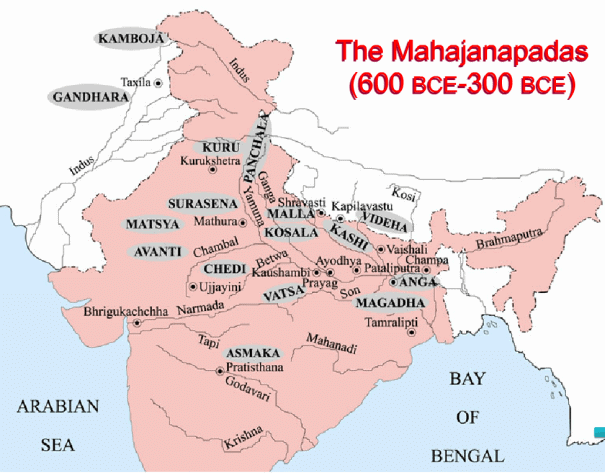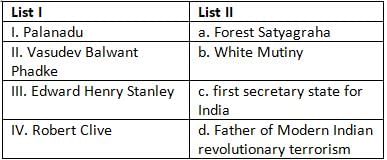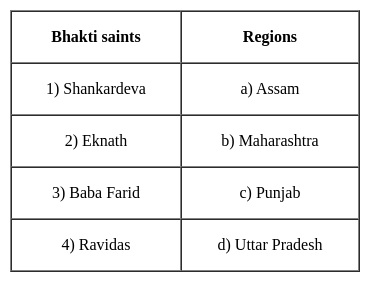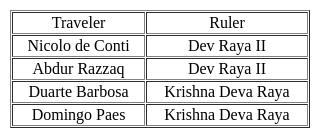MH SET Paper 2 Mock Test - 6 (History) - MAHA TET MCQ
30 Questions MCQ Test MH SET Mock Test Series 2025 - MH SET Paper 2 Mock Test - 6 (History)
Who was one of the finest calligraphers at Akbar’s court who was honoured with the title ‘Zarrin Kalam’?
In ________, the British Government announced certain reforms in the structure of the Government in India, which were known as the Morley-Minto Reforms.
Bagh caves near Gwalior represent the paintings of which of the following era?
What was the immediate cause of the Revolt of 1857?
Consider the following statements regarding the Indus Valley civilization:
1. People were following phallic worship.
2. Mixed types of burial systems were observed.
Which of the following is/are statements are correct?Consider the following statements regarding the Rajput king Raja Sawai Jai Singh of Amber:
1. He established an astronomical observatory in Ujjain.
2. He founded the city of Jaipur.
3. He was given the title of 'Sawai' by Mughal emperor Aurangzeb.
Which of the statements given above are correct?
Match the following Indian Newspapers with their founders and choose the correct answer from the codes given below-
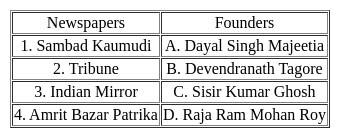
Which one of the following contains the biographies of the sufis of India, and the author presented it to Jahangir?
The most popular title of Ashoka is Devnamapriya Priyadarshi. In how many inscriptions, Ashoka's name 'Ashoka' is found?
Consider the following statement regarding Ashoka's Dhamma:
1. The theme of ahimsa is an important aspect of Ashoka's dhamma and is frequently mentioned.
2. The ceremony of the dhamma is described as consisting of proper courtesy to slaves and servants, respectful behavior towards elders, and liberality to sharmanas and Brahmanas.
3. Major Rock Edict I declares prohibition of animal sacrifice and holiday of festive gatherings.
How many of the above statements are correct?
Consider the following statements about the Pashupati Seal of the Harappan civilization:
i. It was found at Mohen-Jo-Daro.
ii. A human figure in Yogic posture is depicted on the seal.
iii. Marshall coined it, Proto Shiva.
iv. A pictographic inscription of six symbols is inscribed on the seal.
Choose the right answer:
Which of the following statement/s is/are not correct about Vijayanagara empire?
Which among the following proposals were adopted at the Nagpur Congress session, 1920?
1. The programme of non-cooperation was endorsed.
2. Attainment of self-government through constitutional means.
3. Provincial Congress committees on a linguistic basis were organized.
Select the correct answer using the codes given below.
How many Prime Ministers of India have been awarded Bharat Ratna till date?
Consider following statements regarding Indian Parliamentary committee 1893
1). Its members were Sir William Wedderburn and WS Caine
2). It was formed to agitate for entry of Indian subjects into the British Parliament
Which of the above statement(s) is/are correct?
Consider the following statements:
- Main deity is Lord Shiva.
- There is also a Nandi shrine.
- It was built during the Rashtrakuta phase.
- It is completely made in Dravida style
- It is carved out of a portion of a hill.
The statements given above are referring to which one of the following temples?
Which of the following statement(s) is/are correct?
1. The last Mauryan Ruler, Brihadratha was assassinated by his Commander-in-Chief, Pushyamitra Sunga.
2. The last Sunga King, Devabhuti was assassinated by his Brahmana Minister Vasudeva Kanva who ascended the throne.
3. The last Ruler of Kanva dynasty was deposed by Andhras.
Match the following, with reference to the revolutionary activities.
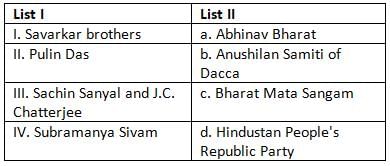
Which among the following event led the British government of Lord North to undertake a legislation to meet the situation and provide some form of legal government for the Indian possessions of the East India Company, which resulted in Regulating Act of 1773?
Consider the following statements regarding the Social life of the Early Vedic Period:
1. The Rig Vedic society was matriarchal.
2. Women were given equal opportunities as men for their spiritual and intellectual development.
3. There was the presence of child marriage.
Which of the statements given above is/are correct?
Mahatma Gandhi said that some of his deepest convictions were reflected in a book titled, “Unto this Last" and the book transformed his life. What was the message from the book that transformed Mahatma Gandhi?
Which among the following system in the Vedic Age has provided for a marriage of a childless widow with the brother of blood relation of her deceased husband for the sake of progeny ?
Which of the following statements is incorrect regarding Pallava’s architecture?
- Although they were mostly Shaivite, some Vaishnava monuments are also seen.
- Their architecture was also influenced by the Buddhist heritage of the Deccan.
- Their early buildings were rock-cut, whereas the later were structural.
Select the correct answer using the codes given below:
|
60 tests
|



